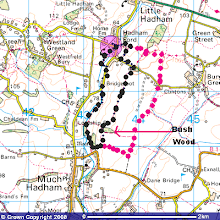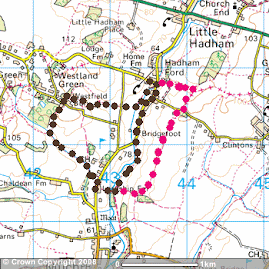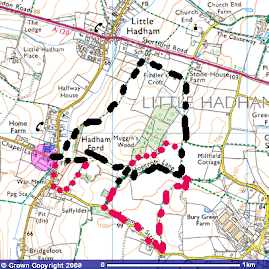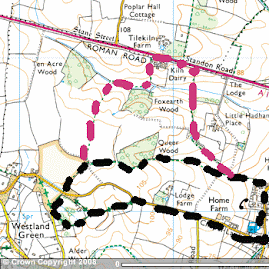The plan was to spend as much time throughout the day in the wood recording all aspects of the natural history of the habitat.
Consequently, I began with a dawn chorus walk, beginning in the village at 4.30a.m. and wandered up the footpaths to the wood, via the polo fields and Millfield Lane. Usual suspects were singing, with plenty of chiffchaff, blackcap and whitethroat. In Hoecroft Lane as we returned to the village at 6.30, the 1st of 3 garden warblers was heard. This is a bird that I have yet to record in Millennium Wood but worth checking for over the next month as they are nearby.
After a quick breakfast, I headed back to the wood with nets, pots, sheets etc and began recording insects, further bird species, including a lesser whitethroat, found by Graeme near the polo field entrance and seen later on by the gate.
Plenty of families joined the recording and we had a huge number of pots containing caterpillars, spiders, bugs, beetles etc that all required identification. As the afternoon went on, in increasingly marvellous temperatures, the list increased and by 2.30, we concluded with a brief walk around the whole wood, listening to bird song and recording the flowering plants.
I returned at 8pm to set the moth trap on what I hoped would be a most productive evening. However, when I came back to check the trap at 10.30pm and have a wander to try and encourage moths to a headtorch and net, it was clear very little was flying, with just 2 moths in the trap. Disappointing as I had 10 moths in the garden trap,
In between times, I spent the hours identifying as many of the potted creatures as possible. Several spiders were not feasible, along with a few flies that were rather worse for wear.
Caterpillars were placed in tubs with their larval foodplant and these will emerge as adults over the summer, when an accurate identification can be made.
All in all, a superb time and wonderful to see so many families participating, with children helping with log searches, netting, sweep netting and beating trees where white sheets were placed underneath to permit good view of all the insects that were knocked out from the branches.
 |
| Back in the moth shed, awaiting identification |
 |
| scorched carpet |
 |
green carpet.
|
List of those creatures identified.
Bio Blitz Day at Millennium Wood
Date: 08.05.16
Weather: high temperature of 26C, still, cloudless. Hottest
day of the year
Recording periods:
5a.m. following
a dawn chorus walk from the village as from 4.30a.m. 1 hour spent in wood
listening to bird song and identifying birds, both by sight and sound. Note:
list contains a few birds that were recorded as flying over, such as lesser black
backed gull and common buzzard.
11a.m. – 2.45p.m. Families searching for invertebrates using several
methods;
·
Checking under logs
·
Beating trees
·
Sweep netting nettles and grasses
·
Butterfly netting flying insects.
8.00p.m. -11.00p.m: Heath 15Watt actinic moth trap set in centre of wood.
Accompanying sheet, illuminated attracted ichneumon wasps and giant craneflies.
Note on English names: where there is no used English name, the species is given, such as Notostira elongata (Mirid bug sp) There are over 220 species of miridae bugs and many have not been given an English name, so the general species is noted. Others are named to specific species name, both the Latin taxon and precise English name.
Odonata
(dragonflies and damselflies)
1.
Pyrrhosoma
nymphula (large red damselfly)
Dermaptera
(earwigs)
1.
Forficula
auricularia (common earwig)
Hemiptera
(Bugs)
1.
Dolycoris
baccarum (Hairy or sloe shieldbug)
2.
Eurydema
oleracea (Crucifer shieldbug)
3. Liocoris tripustulatus
4. Notostira elongata (mirid bug sp)
5.
Eupelix
cuspidata (leafhopper sp)
6.
Aleyrodes
proletella (Cabbage whitefly)
Neuroptera (Lacewings)
1. Chrysopa perla (green lacewing)
Coleoptera (Beetles)
1.
Carabus arvensis
2.
Stomis pumicatus
3. Poecilus cupreus (Copper greenclock)
4. Pterostichus madidus (black clock)
5.
Pterostrichus niger
6.
Syntomus foveatus
7. Meligethes aeneus (Common pollen bettle)
8. Dalopius marginatus (click beetle sp)
9. Propylea quattuordeciimpunctata (14 spot ladybird)
10. Coccinella
septempunctata (7 spot ladybird)
11. Harmonia axyridis (Harlequin ladybird)
12. Cionus scrophulariae (Figwort weevil)
13. Nedyus quadrimaculatus (weevil sp)
14. Phyllobius pyri (Green nettle weevil)
Lepidoptera
(Moths & Butterflies)
1.
Esperia
sulphurella (micro moth)
2.
Stigmella
aurella (micro moth)
3.
Gonepteryx
rhamni (Brimstone butterfly)
4.
Pieris
brassicae (Large white)
5.
Pieris
napi (Green veined white)
6.
Anthocharis
cardamines (Orange tip)
7.
Parage
aegeria (Speckled wood)
8.
Celastrina
argiolus) (Holly Blue)
9.
Colostygia
pectinataria (Green carpet moth)
10.
Ligdia adustata (Scorched carpet)
11.
Eupithecia
abbreviata (Brindled pug)
Of Note: several species of moth, fly and
maybe butterfly larvae were beaten from oak, hawthorn, hornbeam and spindle. These
are now feeding in rearing pots where most will pupate within the next couple
of months and emerge as adults later this year. A rough estimate shows there to
be at least 7 species present. Leaf mines on bramble were also noted and suspected
to be that of Stigmella aurella, a
common micro moth associated with bramble.
Diptera
(Flies)
1.
Nephrotoma
appendiculata (spotted cranefly)
2.
Tipula
lunata (Giant cranefly)
3.
Cylindromata
distinctissima (damsel cranefly sp)
4.
Bibio
marci (St. Mark’s fly)
5.
Dilophus
febrilis (Fever fly)
6.
Xylophagus
ater (Common awl fly)
7.
Empis
stercorea (dance fly sp)
8.
Cheiosia
vernalis (hoverfly sp)
Hymenoptera
(Ants, bees, wasps and relatives)
1.
Tenthredo
mandibularis (sawfly sp)
2.
Ophion
luteus (Ichneumon wasp sp)
3.
Vespa crabro
(hornet)
4.
Vespula
vulgaris (common wasp)
5.
Lasioglossum
morio (brassy mining bee)
6.
Bombus lapidaries
(large red tailed bumble bee)
7.
Bombus
lucorum (white tailed bumble bee)
8.
Lasius
niger (black ant)
Flora (Flowers)
1.
Urtica
dioica (common nettle)
2.
Stellaria
holostea (Greater stitchwort)
3.
Silene
dioica (Red campion)
4.
Ranunculus
acris (meadow buttercup)
5.
Chelidonium
majus (Greater celandine)
6.
Allaria petiolata
(Garlic mustard)
7.
Hedera
helix (ivy)
8.
Anthriscus
sylvestris (cow parsley)
9.
Primula
vulgaris (primrose)
10.
Lamium
purpureum (red dead nettle)
11.
Glechoma
hederacea (ground ivy)
12.
Veronica
chamaedrys (germander speedwell)
13.
Bellis
perennis (daisy)
14.
Taraxacum
officnale (common dandelion)
15.
Arum
maculatum (Lords-and-ladies)
Isopoda
(woodlice)
1.
Porcellio
scaber (woodlouse)
Arthropoda
(centipedes and millipedes)
1.
Tachypodoiulus
niger (white legged snake millipede)
2.
Lithobius
forficalis (common centipede)
Arachnida
(Spiders)
1.
Salticus
scenicus (zebra spider)
2.
Xysticus
cristatus (crab spider sp)
3.
Segestria
senoculata (snake back spider sp)
4.
Araniella
cucurbitina (green orb weaver spider sp)
5.
Metellina
segmentata (common orb spider sp)
Ornithurae
(Birds)
1.
Anas
platyrhynchos (mallard)
2.
Buteo
buteo (common buzzard)
3.
Phasianus
colchicus (pheasant)
4.
Larus
fuscus (lesser black backed gull)
5.
Columba palumbus
(Wood pigeon)
6.
Strix
aluco (tawny owl)
7.
Picus
viridis (Green woodpecker)
8.
Dendrocopus
major (great spotted woodpecker)
9.
Troglodytes
troglodytes (wren)
10.
Prunella
modularis (dunnock)
11.
Erithacus
rubecula (robin)
12.
Turdus
philomelos (song thrush)
13.
Turdus
merula (blackbird)
14.
Sylvia
atricapilla (blackcap)
15.
Sylvia
curruca (lesser whitethroat)
16.
Sylvia
communis (whitethroat)
17.
Phylloscopus
collybita (chiffchaff)
18.
Parus
major (great tit)
19.
Parus
caeruleus (blue tit)
20.
Aegithalos
caudatus (long tailed tit)
21.
Pica pica
(magpie)
22.
Garrulus
glandarius (jay)
23.
Corvus
monedula (jackdaw)
24.
Corvus
frugilegus (rook)
25.
Corvus
corone corone (carrion crow)
26.
Sturnus vulgaris
(starling)
27.
Fringilla
coelebs (chaffinch)
28.
Pyrrhula
pyrrhula (bullfinch)
Mammalia
(animals)
1.
Oryctolagus
cuniculus (rabbit)
2.
Vulpes
vulpes (fox)
3.
Pipistrellus
pipistrellus (pipistrelle bat)




















































